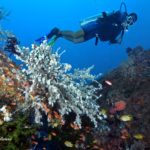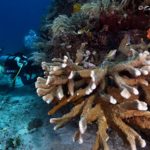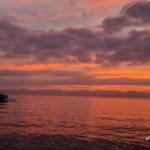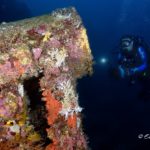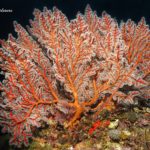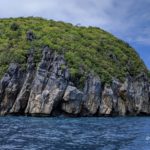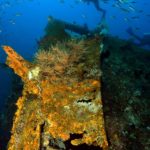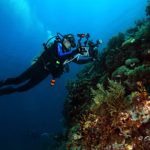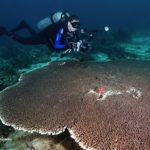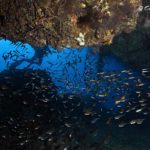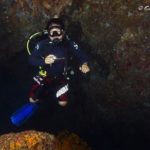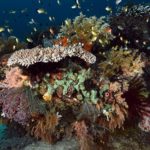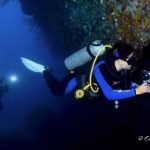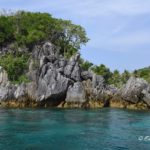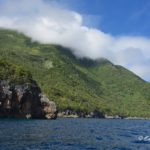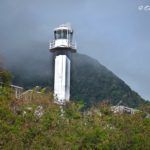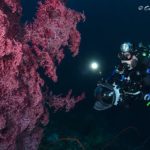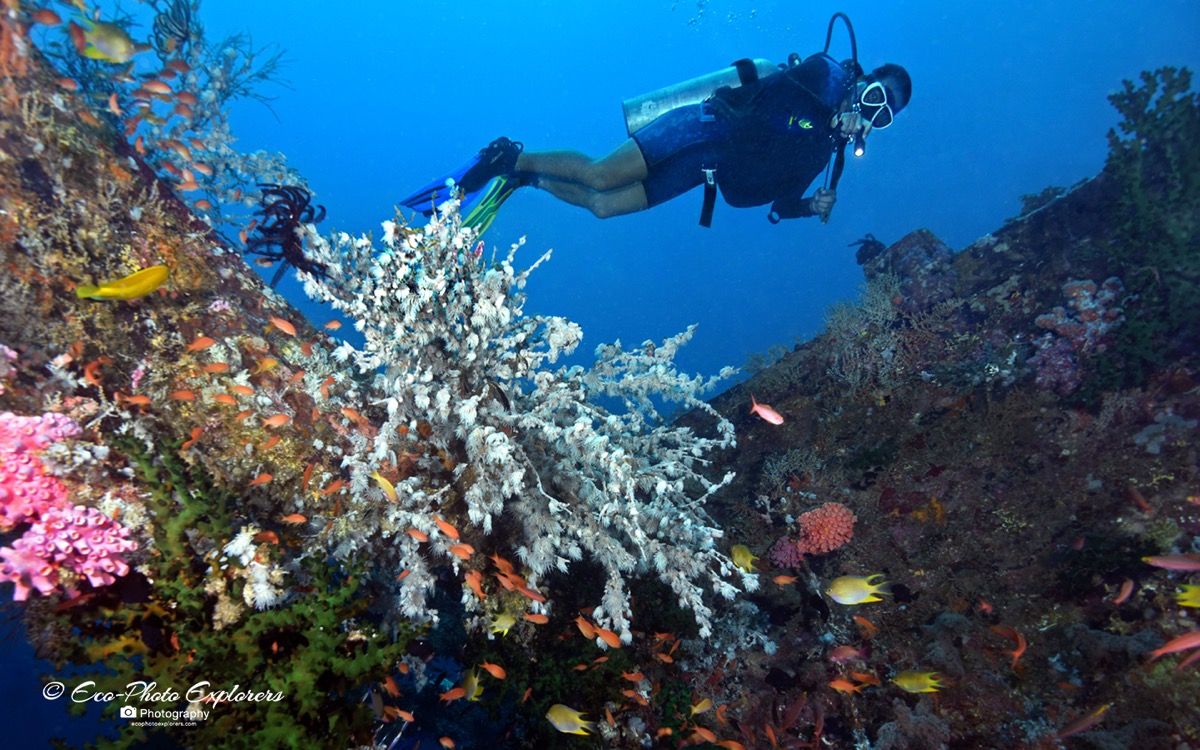
The Mactan Ferry is one of the most beautiful wreck dives in the Philippines
The Philippines are famous for some of the very best dive spots in the world. The remote reefs of Tubbataha, the macro paradise of Dumaguete, the historic shipwrecks of Coron and the center of biodiversity at Verde Island all vie for top honors on scuba diving lists of “must dives”.
Words & Photos by Michael Salvarezza and Christopher P. Weaver
But with over 7000 islands covering an area of over 120,000 square miles of the western Pacific Ocean, and with its location within the Coral Triangle, there are almost limitless opportunities for underwater exploration.
It is with that spirit of discovery that we boarded the Big Beth, an 82-foot custom equipped dive safari boat operated by the Marco Vincent Dive Resort in Puerto Galera on the island Mindoro, and headed 16 hours towards the islands of Tablas and Romblon.
The islands of Romblon and Tablas lie on the southeast side of Mindoro along the Tablas straight. At 324 square miles, Tablas is the largest island in the province of Romblon, which consists of 20 islands, while Romblon Island measures only 33 square miles. Although there is a small domestic airport on Tablas, most of this area can only be reached by boat. The adrenaline rush of exploration was beginning to build.
We arrived early in the morning after an overnight cruise and began gearing up for our first dive, an exploration of a rocky wall off the coast of Tablas known as Gindwahan Cliff. Here, we descended along the dropoff and photographed some of the largest sea fans and gorgonians we had ever seen. We bottomed out at 108 FSW before heading back up along the wall.
Another great dive in this area is a site known as Oregon Rocks. Here, we swam along a descending shelf of large boulders adorned with magnificent hard corals. Cardinal fish were using the crevices and overhangs to stay out of sight while other less timid reef denizens went about their business. The topography and marine life were so interesting here that we even elected to make a second dive at this site.
One of the great aspects of liveaboard diving is the ability to roam further than shore based diving operations can. On an exploratory mission like the one we were taking to Tablas and Romblon, the opportunities to experience the area in new and different ways is always a great feature. How about a beach picnic on a remote and uninhabited stretch of shoreline?
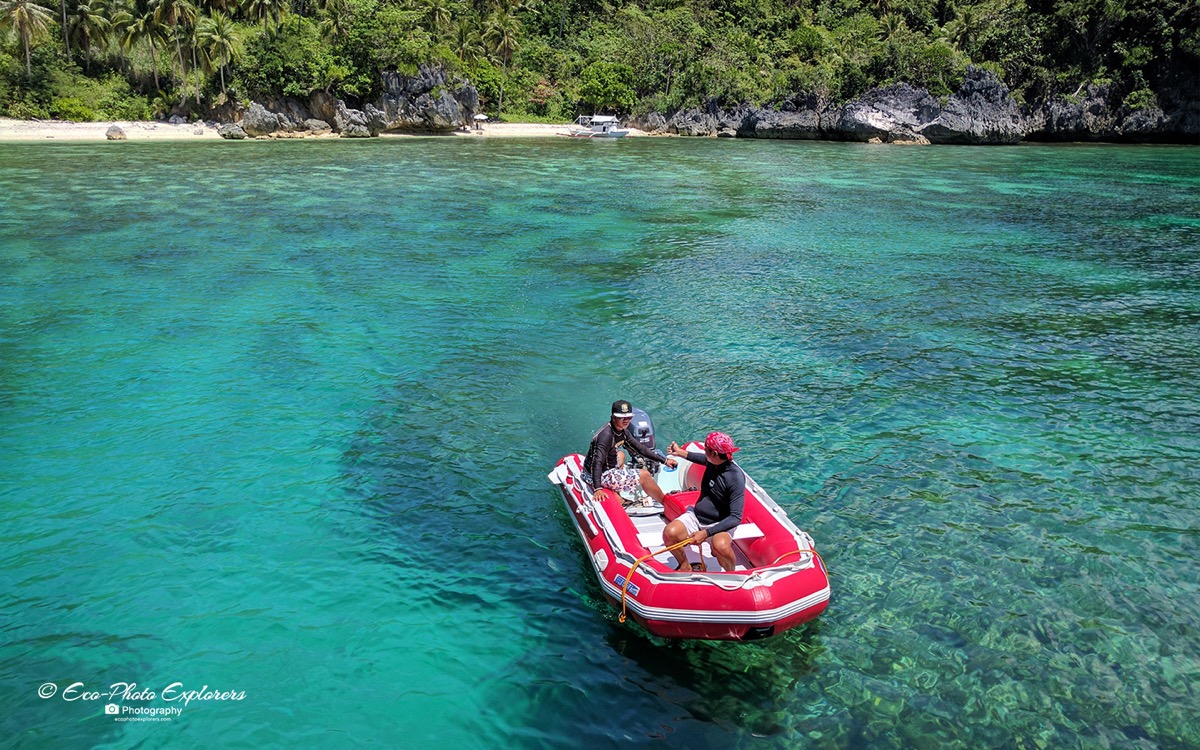
A sheltered lagoon with crystal clear water
We found an isolated cove with crystalline waters and a rocky shoreline that protected a small stretch of tropical beach…perfect for a beach picnic respite from living on the boat! This was an ideal way to spend a surface interval!
After a hearty meal and a relaxing mid-day break it was time to motor over to one of the signature dives in the area: the Blue Hole of Tablas.
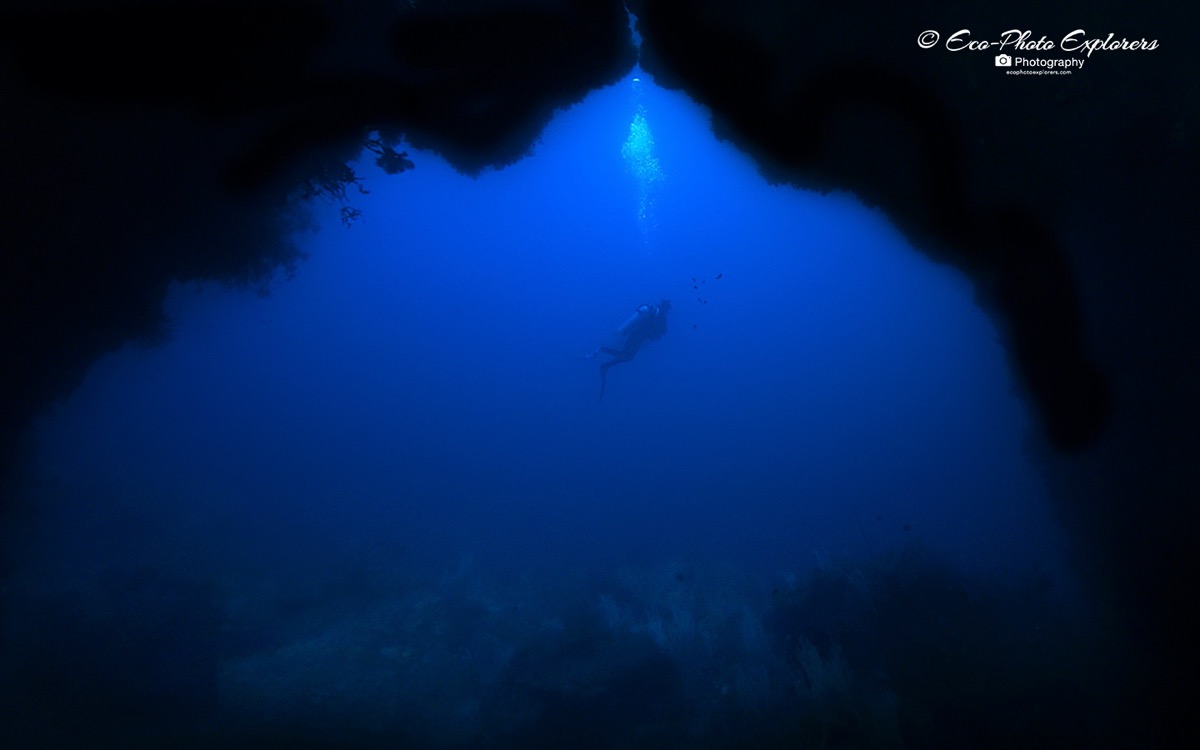
A diver swims outside the blue hole
The Punta Gorda Lighthouse stands guard near the Gorda Wall and marks the Blue Hole entrance. This lighthouse is one of the major lighthouses of the Philippines and was built sometime in the 1930s. The lighthouse stands on the northwestern part of Tablas Island, in the village of Cawayan.
The lighthouse with its ruined keeper’s house has an octagonal concrete tower with lantern and gallery. It stands 213ft (65m) and flashes white every 15 seconds. It guides ships traversing the Sibuyan Sea, particularly those passing through Romblon Pass. For us, it was a key landmark in our search for the Blue Hole.
To explore the Blue Hole of Tablas is to dive into one of the more unique formations in the reef here. After a briefing from a local dive expert, we hit the 80-degree water, cameras in hand, and began a short traverse of the reef searching for the nearly circular opening of the Blue Hole. In a few minutes, we were there.
Slowly, we descended into the tube-like formation, all the while savoring the otherworldly view of the rock walls as we dropped deeper into the vertical cavern. At about 100fsw, the Blue Hole bottoms out. Along the sides of the hole are cutouts that form caverns and caves begging to be explored. Along the way, we spotted schools of timid Cardinalfish seeking shelter in the rocks. Before exiting to the outer reef, we stopped to enjoy an upward looking view of a diver descending into the gloom from above. The Blue Hole at Tablas is not to be missed.
The dive at the Blue Hole concludes with a leisurely swim over a nearby shallow reef. Unfortunately, here we could see the remaining damage from dynamite fishing, a practice that is now illegal but which has caused considerable damage to the reef. It’s a sobering reminder of how fragile the underwater world is. One blast can destroy decades and centuries of coral growth.
Next, we ventured to Romblon Island to explore the reefs along this island, the namesake of the Province of Romblon.

Sea fans grow to unbelievable size in Romblon
Our first dive was in a place called The Coral Sanctuary. Here, like in Tablas, large growth of hard coral caught our eyes, as well as the giant sponges and Sea fans like the ones we saw in Tablas.
The islands are rocky and mountainous, and the boulders and rocks that define the landscape above the water extend below the surface. Takot Rocks and Dinang Rocks are two dive sites at Romblon worth a visit. The hard surfaces of the rocks support coral growth along with providing shelter for myriad indo-pacific species of fish. Here, we also encountered a Green Sea Turtle languidly grazing the rocks for food.
Nearby to Tablas is the wreck of the Mactan Ferry. Sunk in July 1973 during a typhoon as she was en route to Manila from Nasipit, the ship now lies on her side between 60 and 145 fsw and can fairly be considered one of the most beautiful wreck dives in all of the Philippines.
We found the wreck to be covered in marine life and home to vibrant populations of fish and marine invertebrates, including stunningly colorful anemones and their resident anemonefish. The wreck supports such a thriving eco-system that penetrating the wreck is not necessary to enjoy the beauty of the shipwreck.
Of course, being metal-heads from the northeast of the United States, we needed to see inside. We dropped inside and began to explore.
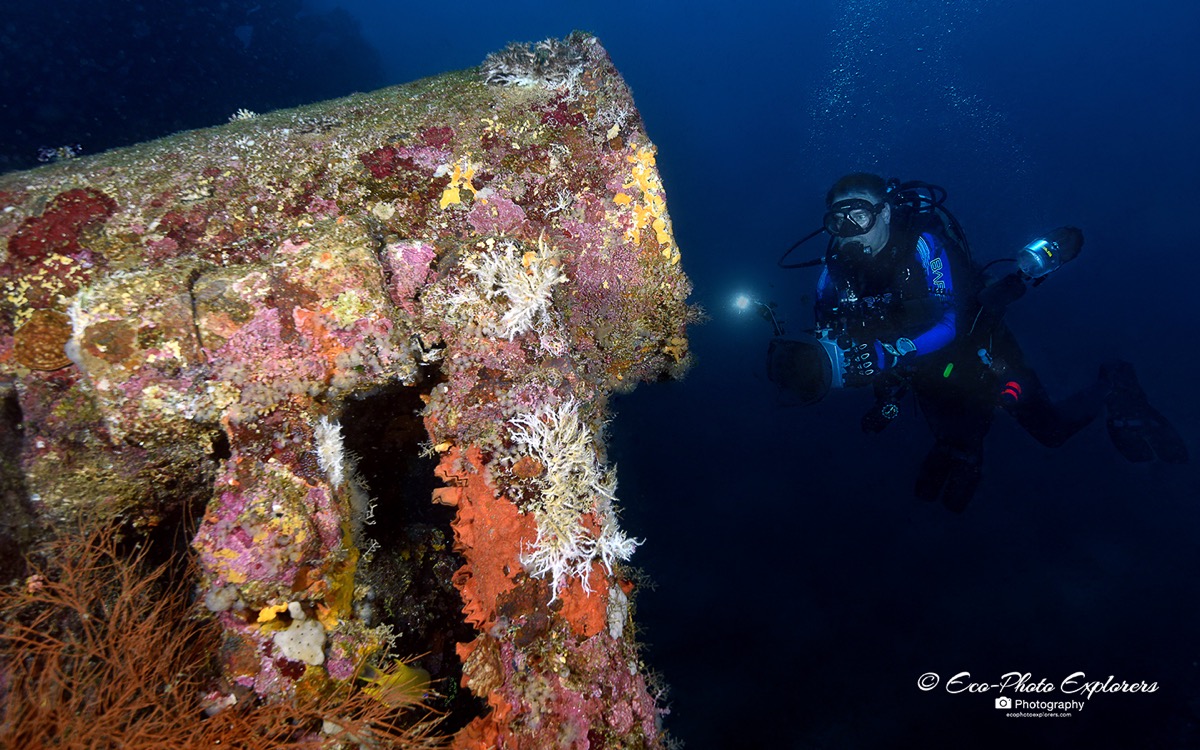
Author Christopher Weaver examines the wreck
Her forward holds and open superstructure do make for fascinating recreational dives, and we could see how tech divers who wish to penetrate the entire length of the ship could get their fill of adventure here as well.
The Mactan Ferry lies near the island of Maestro de Campo, and located in the harbor here are two Japanese wrecks sunk by aerial bombs during the second World War. These two ships, one a cargo vessel and the second a smaller wooden vessel, lie perpendicular to each other in 90 fsw and make for excellent night dives.
When travelling around the archipelago of the Philippines, it sometimes feels as if anywhere you dip your mask into the water will result in another great dive site. That’s what makes exploratory safaris like the one we took to Tablas and Romblon so satisfying. The area doesn’t often get as much press as the other signature locations in the Philippines, but with healthy reefs, fascinating shipwrecks and a dramatic blue hole, we left feeling as if we had barely begun to scratch the surface of what this place has to offer.
Getting There
The gateway city into the Philippines is Manila. Flights arrive from numerous locations around the world, with many convenient connections available through Hong Kong. From Manila, various travel options, including domestic flights and ferry services, are available to other provinces in the country.
For US visitors, a VISA is not required. If you are a citizen of another country, check the VISA requirements before planning your trip.
A valid passport is required for entry, and must be valid for 6 months after arrival.
Immunizations and Medicine
As of the time of this writing, the United States Department of State has issued a Level 3 Travel Advisory for the Philippines regarding COVID-19. This situation changes rapidly so check on all requirements and restrictions before planning travel to the Philippines during the pandemic.
As with any travel to tropical regions, also make sure all your vaccinations are up to date! All travelers should visit their personal physician or a travel health clinic to discuss what vaccinations (e.g., Hepatitis A, Hepatitis B, Malaria, Typhoid, or Tetanus-diphtheria) and travel medicine are recommended. All medicine should be packed in their original, clearly labeled containers. Having a signed and dated letter from a physician describing your medical conditions and medications is suggested.
Note: Travel health clinics usually provide more detailed health protection measures since they specialize in travel medicine. Beware of travelers’ diarrhea, which is the most common travel-related ailment. Insect protection is a must and essential!
Baggage
Baggage allowances vary for each international carrier so check before you leave.
Weather
The Philippines has a tropical climate. There are basically two seasons: the wet season (May-October) and the dry season (November-April). April and May are the two warmest months, marked by high temperatures and humidity. During these months, temperatures can reach 90 degrees F or higher. In the cooler months of December and January, temperatures moderate with less humidity.
The Philippines is in the tropical cyclone belt, and typhoons threaten the region between July and October. Typhoon Yolanda struck the southern regions on November 8, 2013, with devastating results. The damage and affects were limited to the south, however, and Puerto Galera and Verde Island were not affected in any way.
Currency
The local currency is the Philipino Peso but US Dollars are often accepted at all resorts.
Electricity
Power voltage used in the Philippines is 220 Volts (50 Hz). Be sure to double-check your appliance’s compatibility before plugging them in. Converters / adaptors are usually available upon request at your hotel front desk. Travel Adapter: Round Pin Universal Plug
- The Mactan Ferry is one of the most beautiful wreck dives in the Philippines
- The reefs are a mix of hard and soft corals
- Sunset over Tablas
- Idyllic Philippine Beach
- Author Christopher Weaver examines the wreck
- The reefs of Tablas are healthy
- The rocky islands beckon divers
- A diver explores the beautiful Mactan Ferry wreck
- A sheltered lagoon with crystal clear water
- Romblon is home to very large sea fans
- Traditional Philippine outrigger
- Author Christopher Weaver explores the reefs of Tablas
- Soft coral adorn the reefs at Tablas
- Christopher Weaver photographing the reef
- Small silversides thrive inside the Blue Hole
- Exquisitely beautiful soft coral
- A diver swims outside the blue hole
- Entering the Blue Hole
- An explosion of color
- Divers explore the reef near the entrance to the Blue Hole
- Rugged rocks belie the delicate beauty beneath the waterline
- Clouds tumble over the island of Tablas
- The Punta Gorda lighthouse is a good landmark to find the Blue Hole
- Sea fans grow to unbelievable size in Romblon
- Descending along the reef wall

